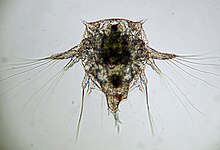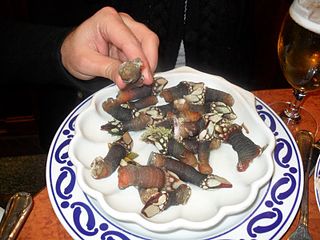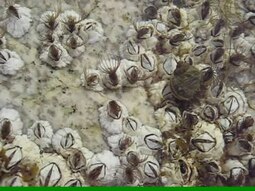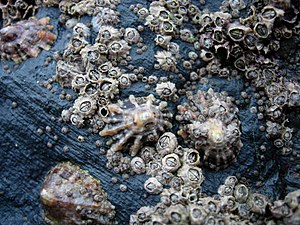Barnacle
| Barnacle | |
|---|---|

| |
| Chthamalus stellatus | |
| Scientific classification | |
| Kingdom: | Animalia |
| Phylum: | Arthropoda |
| Subphylum: | Crustacea |
| Class: | Thecostraca |
| Subclass: | Cirripedia Burmeister, 1834 |
| Infraclasses | |
| |
| Synonyms | |
|
Thyrostraca, Cirrhopoda, Cirrhipoda, and Cirrhipedia. | |
A barnacle is a type of arthropod constituting the subclass Cirripedia in the subphylum Crustacea, and is hence related to crabs and lobsters. Barnacles are exclusively marine, and tend to live in shallow and tidal waters, typically in erosive settings. They are sessile (nonmobile) and most are suspension feeders, but those in infraclass Rhizocephala are highly specialized parasites on crustaceans. They have four nektonic (active swimming) larval stages. Around 1,000 barnacle species are currently known.[1] The name "Cirripedia" is Latin, meaning "curl-footed".[2] The study of barnacles is called cirripedology.
Description[]

Barnacles are encrusters, attaching themselves temporarily to a hard substrate or a symbiont such as a whale, sea snake or lobster. The most common, "acorn barnacles" (Sessilia), are sessile, growing their shells directly onto the substrate.[3] Pedunculate barnacles (goose barnacles and others) attach themselves by means of a stalk.[3]
Free-living barnacles are attached to the substratum by cement glands that form the base of the first pair of antennae; in effect, the animal is fixed upside down by means of its forehead. In some barnacles, the cement glands are fixed to a long, muscular stalk, but in most they are part of a flat membrane or calcified plate. A ring of plates surrounds the body, homologous with the carapace of other crustaceans. These consist of the rostrum, two lateral plates, two carinolaterals, and a carina.[4] In sessile barnacles, the apex of the ring of plates is covered by an operculum, which may be recessed into the carapace. The plates are held together by various means, depending on species, in some cases being solidly fused.[citation needed]
Inside the carapace, the animal lies on its stomach, with its limbs projecting downwards. Segmentation is usually indistinct, and the body is more or less evenly divided between the head and thorax, with little, if any, abdomen. Adult barnacles have few appendages on their heads, with only a single, vestigial pair of antennae, attached to the cement gland. The eight pairs of thoracic limbs are referred to as "cirre", which are feathery and very long, being used to filter food, such as plankton, from the water and move it towards the mouth.[citation needed]
Barnacles have no true heart, although a sinus close to the esophagus performs a similar function, with blood being pumped through it by a series of muscles. The blood vascular system is minimal. Similarly, they have no gills, absorbing oxygen from the water through their limbs and the inner membrane of their carapaces. The excretory organs of barnacles are maxillary glands.[citation needed]
The main sense of barnacles appears to be touch, with the hairs on the limbs being especially sensitive. The adult also has three photoreceptors (ocelli), one median and two lateral. These photoreceptors record the stimulus for the barnacle shadow reflex, where a sudden decrease in light causes cessation of the fishing rhythm and closing of the opercular plates.[5] The photoreceptors are likely only capable of sensing the difference between light and dark.[6] This eye is derived from the primary naupliar eye.[7]
Life cycle[]
Barnacles have two distinct larval stages, the nauplius and the cyprid, before developing into a mature adult.
Nauplius[]


A fertilised egg hatches into a nauplius: a one-eyed larva comprising a head and a telson, without a thorax or abdomen. This undergoes six moults, passing through five instars, before transforming into the cyprid stage. Nauplii are typically initially brooded by the parent, and released after the first moult as larvae that swim freely using setae.[9][10]
Cyprid[]
The cyprid larva is the last larval stage before adulthood. It is not a feeding stage; its role is to find a suitable place to settle, since the adults are sessile.[9] The cyprid stage lasts from days to weeks. It explores potential surfaces with modified antennules; once it has found a potentially suitable spot, it attaches head-first using its antennules and a secreted glycoproteinous substance. Larvae assess surfaces based upon their surface texture, chemistry, relative wettability, color, and the presence or absence and composition of a surface biofilm; swarming species are also more likely to attach near other barnacles.[11] As the larva exhausts its finite energy reserves, it becomes less selective in the sites it selects. It cements itself permanently to the substrate with another proteinaceous compound, and then undergoes metamorphosis into a juvenile barnacle.[11]
Adult[]
Typical acorn barnacles develop six hard calcareous plates to surround and protect their bodies. For the rest of their lives, they are cemented to the substrate, using their feathery legs (cirri) to capture plankton.
Once metamorphosis is over and they have reached their adult form, barnacles continue to grow by adding new material to their heavily calcified plates. These plates are not moulted; however, like all ecdysozoans, the barnacle itself will still moult its cuticle.[12]
Sexual reproduction[]
Most barnacles are hermaphroditic, although a few species are gonochoric or androdioecious. The ovaries are located in the base or stalk, and may extend into the mantle, while the testes are towards the back of the head, often extending into the thorax. Typically, recently moulted hermaphroditic individuals are receptive as females. Self-fertilization, although theoretically possible, has been experimentally shown to be rare in barnacles.[13][14]
The sessile lifestyle of barnacles makes sexual reproduction difficult, as the organisms cannot leave their shells to mate. To facilitate genetic transfer between isolated individuals, barnacles have extraordinarily long penises. Barnacles probably have the largest penis to body size ratio of the animal kingdom,[13] up to eight times their body length.[15]
Barnacles can also reproduce through a method called spermcasting, in which the male barnacle releases his sperm into the water and females pick it up and fertilise their eggs.[16]
The Rhizocephala superorder used to be considered hermaphroditic, but it turned out that its males inject themselves into the female's body, degrading to the condition of nothing more than sperm-producing cells.[17]
Ecology[]
Most barnacles are suspension feeders; they dwell continually in their shells, which are usually constructed of six plates,[3] and reach into the water column with modified legs. These feathery appendages beat rhythmically to draw plankton and detritus into the shell for consumption.[18]
Other members of the class have quite a different mode of life. For example, members of the superorder Rhizocephala, including the genus Sacculina, are parasitic and live within crabs.[19]
Although they have been found at water depths to 600 m (2,000 ft),[3] most barnacles inhabit shallow waters, with 75% of species living in water depths less than 100 m (300 ft),[3] and 25% inhabiting the intertidal zone.[3] Within the intertidal zone, different species of barnacles live in very tightly constrained locations, allowing the exact height of an assemblage above or below sea level to be precisely determined.[3]
Since the intertidal zone periodically desiccates, barnacles are well adapted against water loss. Their calcite shells are impermeable, and they possess two plates which they can slide across their apertures when not feeding. These plates also protect against predation.[20]
Barnacles are displaced by limpets and mussels, which compete for space. They also have numerous predators.[3] They employ two strategies to overwhelm their competitors: "swamping" and fast growth. In the swamping strategy, vast numbers of barnacles settle in the same place at once, covering a large patch of substrate, allowing at least some to survive in the balance of probabilities.[3] Fast growth allows the suspension feeders to access higher levels of the water column than their competitors, and to be large enough to resist displacement; species employing this response, such as the aptly named Megabalanus, can reach 7 cm (3 in) in length;[3] other species may grow larger still (Austromegabalanus psittacus).
Competitors may include other barnacles, and disputed evidence indicates balanoid barnacles competitively displaced chthalamoid barnacles. Balanoids gained their advantage over the chthalamoids in the Oligocene, when they evolved tubular skeletons, which provide better anchorage to the substrate, and allow them to grow faster, undercutting, crushing, and smothering chthalamoids.[21]
Among the most common predators on barnacles are whelks. They are able to grind through the calcareous exoskeletons of barnacles and feed on the softer inside parts. Mussels also prey on barnacle larvae.[22] Another predator on barnacles is the starfish species Pisaster ochraceus.[23][24]
Barnacles and limpets compete for space in the intertidal zone

Goose barnacles, with their cirri extended for feeding

Underside of large Chesaconcavus sp. (Miocene) showing internal plates in bioimmured smaller barnacles
The anatomy of parasitic barnacles is generally simpler than that of their free-living relatives. They have no carapace or limbs, having only unsegmented sac-like bodies. Such barnacles feed by extending thread-like rhizomes of living cells into their hosts' bodies from their points of attachment.[6]
History of taxonomy[]

Barnacles were originally classified by Linnaeus and Cuvier as Mollusca, but in 1830 John Vaughan Thompson published observations showing the metamorphosis of the nauplius and cypris larvae into adult barnacles, and noted how these larvae were similar to those of crustaceans. In 1834 Hermann Burmeister published further information, reinterpreting these findings. The effect was to move barnacles from the phylum of Mollusca to Articulata, showing naturalists that detailed study was needed to reevaluate their taxonomy.[25]
Charles Darwin took up this challenge in 1846, and developed his initial interest into a major study published as a series of monographs in 1851 and 1854.[25] Darwin undertook this study, at the suggestion of his friend Joseph Dalton Hooker, to thoroughly understand at least one species before making the generalisations needed for his theory of evolution by natural selection.[26]
Classification[]
Some authorities regard the Cirripedia as a full class or subclass, and the orders listed above are sometimes treated as superorders. In 2001, Martin and Davis placed Cirripedia as an infraclass of Thecostraca and divided it into six orders:[27]
- Infraclass Cirripedia Burmeister, 1834
- Superorder Acrothoracica Gruvel, 1905
- Order Pygophora Berndt, 1907
- Order Apygophora Berndt, 1907
- Superorder Rhizocephala Müller, 1862
- Order Kentrogonida Delage, 1884
- Order Akentrogonida Häfele, 1911
- Superorder Thoracica Darwin, 1854
- Superorder Acrothoracica Gruvel, 1905
In 2021, Chan et al. elevated Cirripedia to subclass of the class Thecostraca, and the superorders Acrothoracica, Rhizocephala, and Thoracica to infraclass. The updated classification, which now includes 11 orders, has been accepted in the World Register of Marine Species.[28][29]
- Subclass Cirripedia Burmeister, 1834
- Infraclass Acrothoracica Gruvel, 1905
- Order Cryptophialida Kolbasov, Newman & Hoeg, 2009
- Order Lithoglyptida Kolbasov, Newman & Hoeg, 2009
- Infraclass Rhizocephala Müller, 1862
- Infraclass Thoracica Darwin, 1854
- Superorder Gale, 2019
- Order Iblomorpha Buckeridge & Newman, 2006
- Order † Eolepadomorpha Chan et al., 2021
- Superorder Gale, 2015
- Order Calanticomorpha Chan et al., 2021
- Order Pollicipedomorpha Chan et al., 2021
- Order Scalpellomorpha Buckeridge & Newman, 2006
- Order † Archaeolepadomorpha Chan et al., 2021
- Order † Brachylepadomorpha Withers, 1923
- (Unranked) Sessilia
- Order Balanomorpha Pilsbry, 1916
- Order Verrucomorpha Pilsbry, 1916
- Superorder Gale, 2019
- Infraclass Acrothoracica Gruvel, 1905
Fossil record[]
The oldest definitive fossil barnacle is from the mid-Carboniferous, around 330-320 million years ago.[30] Older claimed barnacles such as Priscansermarinus from the Middle Cambrian (on the order of 510 to 500 million years ago)[31] do not show clear barnacle morphological traits.[30] Barnacles first radiated and became diverse during the Late Cretaceous. Barnacles underwent a second, much larger radiation during the Neogene (last 23 million years), which continues to present.[30] In part, their poor skeletal preservation is due to their restriction to high-energy environments, which tend to be erosional – therefore it is more common for their shells to be ground up by wave action than for them to reach a depositional setting.
Barnacles can play an important role in estimating paleo-water depths. The degree of disarticluation of fossils suggests the distance they have been transported, and since many species have narrow ranges of water depths, it can be assumed that the animals lived in shallow water and broke up as they were washed down-slope. The completeness of fossils, and nature of damage, can thus be used to constrain the tectonic history of regions.[3]

Balanus improvisus, one of the many barnacle taxa described by Charles Darwin
Miocene (Messinian) Megabalanus, smothered by sand and fossilised

Chesaconcavus, a Miocene barnacle from Maryland
Relationship with humans[]
Barnacles are of economic consequence, as they often attach themselves to synthetic structures, sometimes to the structure's detriment. Particularly in the case of ships, they are classified as fouling organisms.[32] The amount and size of barnacles that cover ships can impair their efficiency by causing hydrodynamic drag. This is not a problem for boats on inland waterways, as barnacles are exclusively marine.[33] Uzun et al. (2020) provide a simplified approach for estimating the effect of real barnacle settlement in nature on the resistance and effective power of the ship.[34] The stable isotope signals in the layers of barnacle shells can potentially be used as a forensic tracking method[35] for whales, loggerhead turtles[36] and marine debris, such as shipwrecks or a flaperon suspected to be from Malaysia Airlines Flight 370.[37][38][39]
The flesh of some barnacles is routinely consumed by humans, including Japanese goose barnacles (e.g. Capitulum mitella), and goose barnacles (e.g. Pollicipes pollicipes), a delicacy in Spain and Portugal.[40] The resemblance of this barnacle's fleshy stalk to a goose's neck gave rise, in ancient times, to the notion that geese literally grew from the barnacle. Indeed, the word "barnacle" originally referred to a species of goose, the barnacle goose Branta leucopsis, whose eggs and young were rarely seen by humans because it breeds in the remote Arctic.[41]
Additionally, the picoroco barnacle is used in Chilean cuisine and is one of the ingredients in curanto seafood stew.
MIT researchers developed an adhesive, inspired by a protein-based bioglue produced by barnacles to firmly attach to rocks, which can form a tight seal to halt bleeding within about 15 seconds of application.[42]

Barnacles attached to pilings along the Siuslaw River in Oregon.

Goose barnacle being enjoyed in a Spanish restaurant in Madrid
See Also[]
References[]
- ^ Martin Walters & Jinny Johnson (2007). The World of Animals. Bath, Somerset: Parragon. ISBN 978-1-4054-9926-2.[page needed]
- ^ Concise Oxford English Dictionary (10th ed.). Oxford University Press. 2002. p. 260. ISBN 0-19-860572-2.
- ^ Jump up to: a b c d e f g h i j k P. Doyle; A. E. Mather; M. R. Bennett; A. Bussell (1997). "Miocene barnacle assemblages from southern Spain and their palaeoenvironmental significance". Lethaia. 29 (3): 267–274. doi:10.1111/j.1502-3931.1996.tb01659.x.
- ^ Kado, Ryusuke. "Let's learn about the body structure of a barnacle" (PDF). Archived from the original (PDF) on January 25, 2012.
- ^ Gwilliam, G.F.; Millecchia, R. J. (January 1975). "Barnacle photoreceptors: Their physiology and role in the control of behavior". Progress in Neurobiology. 4: 211–239. doi:10.1016/0301-0082(75)90002-7. S2CID 53164671.
- ^ Jump up to: a b Barnes, Robert D. (1982). Invertebrate Zoology. Holt-Saunders International. pp. 694–707. ISBN 978-0-03-056747-6.
- ^ Lacalli, Thurston C. (September 2009). "Serial EM analysis of a copepod larval nervous system: Naupliar eye, optic circuitry, and prospects for full CNS reconstruction". Arthropod Structure & Development. 38 (5): 361–375. doi:10.1016/j.asd.2009.04.002. PMID 19376268.
- ^ Pérez-Losada, Marcos; Høeg, Jens T; Crandall, Keith A (17 April 2009). "Remarkable convergent evolution in specialized parasitic Thecostraca (Crustacea)". BMC Biology. 7 (1): 15. doi:10.1186/1741-7007-7-15. PMC 2678073. PMID 19374762.
- ^ Jump up to: a b William A. Newman (2007). "Cirripedia". In Sol Felty Light; James T. Carlton (eds.). The Light and Smith Manual: Intertidal Invertebrates from Central California to Oregon (4th ed.). University of California Press. pp. 475–484. ISBN 978-0-520-23939-5.
- ^ Ruppert, Edward E.; Fox, Richard, S.; Barnes, Robert D. (2004). Invertebrate Zoology (7th ed.). Cengage Learning. p. 683. ISBN 978-81-315-0104-7.
- ^ Jump up to: a b Donald Thomas Anderson (1994). "Larval development and metamorphosis". Barnacles: Structure, Function, Development and Evolution. Springer. pp. 197–246. ISBN 978-0-412-44420-3.
- ^ E. Bourget (1987). Barnacle shells: composition, structure, and growth. pp. 267–285. In A. J. Southward (ed.), 1987.
- ^ Jump up to: a b "Biology of Barnacles". Museum Victoria. 1996. Archived from the original on February 17, 2007. Retrieved April 20, 2012.
- ^ E. L. Charnov (1987). Sexuality and hermaphroditism in barnacles: A natural selection approach. pp. 89–104. In A. J. Southward (ed.), 1987.
- ^ Ewen Callaway (2009-04-07). "Penis length isn't everything … for barnacle males". New Scientist. Retrieved 2020-10-03.
- ^ "Barnacles Leak Sperm Into Ocean, Upending Mating Theory". National Geographic Society Newsroom. 15 January 2013.
- ^ Mechanism of Fertilization: Plants to Humans, edited by Brian Dale
- ^ "Shore life". Encarta Encyclopedia 2005 DVD.
- ^ Carl Zimmer (2000). Parasite Rex: Inside the Bizarre World of Nature's Most Dangerous Creatures. Free Press. ISBN 978-0-7432-0011-0.
- ^ Leone, Stacy E. (2008). Predator Induced Plasticity in Barnacle Shell Morphology (Master of Arts in Biology thesis). Central Connecticut State University. OCLC 713734094.[page needed]
- ^ Stanley, Steven M. (8 April 2016). "Predation defeats competition on the seafloor". Paleobiology. 34 (1): 1–21. doi:10.1666/07026.1. S2CID 83713101.
- ^ Clint Twist (2005). Visual Factfinder: Oceans. Great Bardfield, Essex: Miles Kelly Publishing.
- ^ Harley, C. D. G.; Pankey, M. S.; Wares, J. P.; Grosberg, R. K.; Wonham, M. J. (December 2006). "Color Polymorphism and Genetic Structure in the Sea Star". The Biological Bulletin. 211 (3): 248–262. doi:10.2307/4134547. JSTOR 4134547. PMID 17179384. S2CID 18549566.
- ^ Jan Holmes (2002). "Seashore players most successful when they're in their zone". WSU Beach Watchers. Archived from the original on 2010-06-21. Retrieved March 6, 2010.
- ^ Jump up to: a b Richmond, Marsha (January 2007). "Darwin's Study of the Cirripedia". Darwin Online. Retrieved 16 June 2012.
- ^ Étienne Benson. "Charles Darwin". SparkNotes. Archived from the original on 29 September 2007. Retrieved August 30, 2007.
- ^ Martin, Joel W.; Davis, George E. (2001). An Updated Classification of the Recent Crustacea. CiteSeerX 10.1.1.79.1863.[page needed]
- ^ Chan, Benny K. K.; Dreyer, Niklas; Gale, Andy S.; Glenner, Henrik; et al. (2021). "The evolutionary diversity of barnacles, with an updated classification of fossil and living forms". Zoological Journal of the Linnean Society. doi:10.1093/zoolinnean/zlaa160.
- ^ "World Register of Marine Species, subclass Cirripedia". Retrieved 2021-08-22.
- ^ Jump up to: a b c Chan, Benny K K; Dreyer, Niklas; Gale, Andy S; Glenner, Henrik; Ewers-Saucedo, Christine; Pérez-Losada, Marcos; Kolbasov, Gregory A; Crandall, Keith A; Høeg, Jens T (2021-02-25). "The evolutionary diversity of barnacles, with an updated classification of fossil and living forms". Zoological Journal of the Linnean Society (zlaa160). doi:10.1093/zoolinnean/zlaa160. ISSN 0024-4082.
- ^ B. A. Foster & J. S. Buckeridge (1987). Barnacle palaeontology. pp. 41–63. In A. J. Southward (ed.), 1987.
- ^ "Newcastle University Biofouling Group". Newcastle University. Archived from the original on June 5, 2009. Retrieved January 15, 2010.
- ^ Demirel, Yigit Kemal; Uzun, Dogancan; Zhang, Yansheng; Fang, Ho-Chun; Day, Alexander H.; Turan, Osman (5 October 2017). "Effect of barnacle fouling on ship resistance and powering". Biofouling. 33 (10): 819–834. doi:10.1080/08927014.2017.1373279. PMID 28980835.
- ^ Uzun, Dogancan; Ozyurt, Refik; Demirel, Yigit Kemal; Turan, Osman (2020-02-01). "Does the barnacle settlement pattern affect ship resistance and powering?". Applied Ocean Research. 95: 102020. doi:10.1016/j.apor.2019.102020. ISSN 0141-1187.
- ^ Pearson, Ryan M.; van de Merwe, Jason P.; Gagan, Michael K.; Connolly, Rod M. (2020). "Unique Post-telemetry Recapture Enables Development of Multi-Element Isoscapes From Barnacle Shell for Retracing Host Movement". Frontiers in Marine Science. 7. doi:10.3389/fmars.2020.00596. ISSN 2296-7745.
- ^ Pearson, Ryan M.; van de Merwe, Jason P.; Gagan, Michael K.; Limpus, Colin J.; Connolly, Rod M. (25 April 2019). "Distinguishing between sea turtle foraging areas using stable isotopes from commensal barnacle shells". Scientific Reports. 9 (1): 6565. Bibcode:2019NatSR...9.6565P. doi:10.1038/s41598-019-42983-4. PMC 6483986. PMID 31024029.
- ^ "Can Barnacles unlock the secrets of MH370 and Turtle migration?". Griffith Sciences Impact. 3 August 2015.
- ^ Pandey, Swati (3 August 2015). "Barnacles on debris could provide clues to missing MH370: experts". Reuters.
- ^ Pearson, Ryan M.; van de Merwe, Jason P.; Connolly, Rod M. (2020). "Global oxygen isoscapes for barnacle shells: Application for tracing movement in oceans". Science of the Total Environment. 705: 135782. doi:10.1016/j.scitotenv.2019.135782. ISSN 0048-9697. PMID 31787294.
- ^ Molares, José; Freire, Juan (December 2003). "Development and perspectives for community-based management of the goose barnacle (Pollicipes pollicipes) fisheries in Galicia (NW Spain)" (PDF). Fisheries Research. 65 (1–3): 485–492. doi:10.1016/j.fishres.2003.09.034. hdl:2183/90.
- ^ "...all the evidence shows that the name was originally applied to the bird which had the marvellous origin, not to the shell..." Oxford English Dictionary, 2nd Edition, 1989
- ^ Hyunwoo Yuk et al. (2021). "Rapid and coagulation-independent haemostatic sealing by a paste inspired by barnacle glue". Nature Biomedical Engineering. doi:10.1038/s41551-021-00769-y.CS1 maint: uses authors parameter (link)
Further reading[]
- Alan J. Southward, ed. (1987-06-01). Barnacle Biology. Crustacean Issues. 5. Leiden, Netherlands: CRC Press / A. A. Balkema. ISBN 978-90-6191-628-4.
External links[]
| Wikimedia Commons has media related to Cirripedia. |
| Wikispecies has information related to Cirripedia. |
- Barnacles from the Marine Education Society of Australasia
- Barnacles in Spain Article on barnacles in Spain, and their collection and gastronomy.
- Darwin, C. R. (1852). The Lepadidæ. A monograph of the sub-class Cirripedia, with figures of all the species. 1. London: Ray Society.
- Darwin, C. R. (1854). The Balanidæ, (or sessile cirripedes); the Verrucidæ, etc. A monograph of the sub-class Cirripedia, with figures of all the species. 2. London: Ray Society.
- Calman, William Thomas (1911). . Encyclopædia Britannica. 3 (11th ed.). p. 409.
- Stebbing, Thomas Roscoe Rede (1911). . Encyclopædia Britannica. 26 (11th ed.). pp. 905–906.
- Parasitic crustaceans
- Barnacles
- Maxillopoda
- Extant Cambrian first appearances








